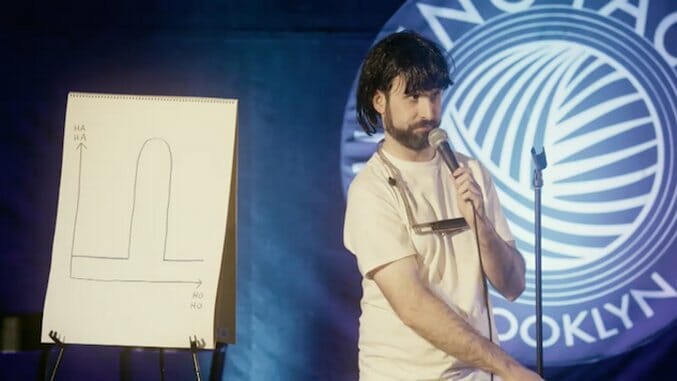
Last week Seeso release Schtick or Treat, a cosplay comedy convergence hosted by seasoned stand-ups Mark Normand and Matt Ruby at the Knitting Factory in Brooklyn. In the hourlong special, stand-ups dressed as A-list names both alive and dead, relevant and irrelevant, beloved and detested. Schtick or Treat was an opportunity for these comics to channel themselves through celebrity costumes, writing jokes in the styles and hyperbolizing the infamous traits of whomever they were impersonating.
There was Justin Williams’ take on Bill Cosby, for example, in which he exaggerated that slurry, exasperated delivery he’s known for (I can’t even type “exaggerated” or “exasperated” without imagining William’ Cosby yowling the words). He made a few on-the-nose allusions to sexual assault—desperately offering to, after his set was done, chat-up any girls “with the dreams” over by the bar (“I will be there,” he stated, “or [in] prison!”). When Williams first walked on stage, the response was slightly lukewarm, because, shit, don’t you think an impersonation might be a little too soon? But, by playing him as desperate and wretched, Williams amusingly illustrated Cosby’s fall from grace.
The immediate follow-up was an impersonation of Charlie Chaplin, played by Nick Vatterott, who did a no-talking shtick that showed him struggling to untangle his earbuds (such an un-lifehackable, #relatable woe). While it can get a little cringe-worthy to watch someone attempt to take a famous person from the past and get them hip with the trends and technology of today, Vatterott’s bit actually turned out to be pretty funny. He snipped the cord of his earbuds, somehow thinking that’d solve his tangled dilemma; then he pulled a surge protector from his pants—voila. It’s interesting, though, that while Williams’ impersonation directly dealt with his subject’s crimes, Vatterott seemed naive to—or at least uninterested in—the fact that Chaplin had known sexual relationships with minors and avoided statutory rape charges. Witnessing this dichotomy within back-to-back sets was a little disconcerting; other than that, Vatterott was very enjoyable.
He wasn’t the only comic to take the approach of getting a figure from the past hip with stuff from today. Dina Hashem’s Pee-Wee Herman nailed his nasally and throaty voices, and she based her longest joke on a guy with no hands who was addicted to Tinder. Then there was Andy Pitz’s “Modern Day” Rodney Dangerfield, which was a drawn-out slew of references to Tinder, Snapchat, Google Earth and Twitter. “I signed up on Tinder,” he mentioned. No one ever says it that way; people say “I got Tinder” or, at the most, “I got a Tinder.” It’s hard to decipher whether this is Pitz’s lack of familiarity with app-related lingo, or if this was intended to be “Modern Day” Dangerfield’s lack thereof—or both.
When stand-ups weren’t opting for the “Modern Day” trope, they were at their funniest impersonating someone of the opposite sex, like Hashem’s Pee-Wee and a few others. Brett Druck and Anthony Kapfer opened the show as Garfunkel & Oates, respectively, playing a great song about consensual anal sex. “You love butt-stuff, and I love you / so I guess that means that I love butt-stuff too,” they harmonize at the end. Amber Nelson nailed Gilbert Gottfried’s signature abrasive whine, amplifying his tastelessness (“shock-value”) with jokes about oral sex. She also referenced Gottfried’s fallout with Aflac, which was the result of his tastelessness at its most inappropriate, when he joked on Twitter about the 2011 earthquake in Japan right after it happened. Nelson, like Druck, Kapfer and Hashem, tapped expertly into the absurdity that’s so inherent to the act of playing dress-up, which was the whole crux of this event.
But the best act overall was Doogie Horner’s Demetri Martin. His awkward silences were paced so methodically, the timing of his acoustic guitar (which he claimed he didn’t even know how to play) crashing to the ground was perfect, and I loved his bit about graphs and charts—one of which was merely a bell curve meant to look like a dick. It was the ideal balance of deadpan, gauche and childish. When stand-ups used celebrity comics as the groundwork and subtly blended in their own unique styles, like Horner’s Martin, they produced a gratifying blend of the impersonation as influencer and impersonator as descendant. This was how the premise of Schtick or Treat got executed best.